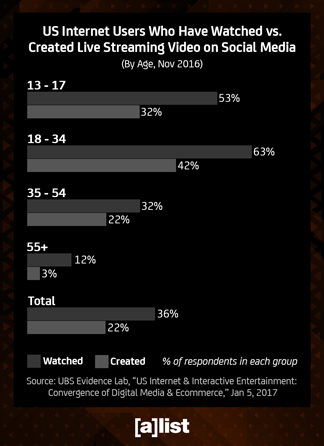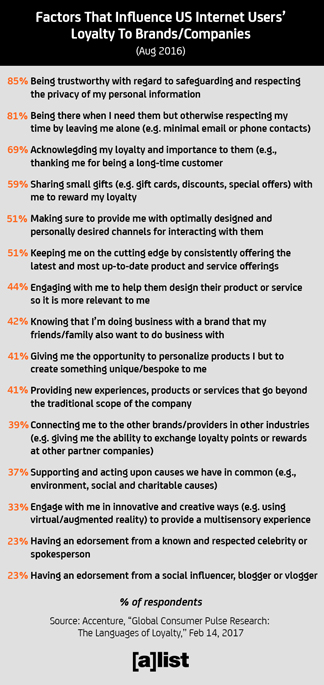This week, we take a look at what makes a consumer loyal, why more people are switching to messenger apps and in case you didn’t notice . . . Ferrari is still pretty cool.
Messaging On Mobile
It’s hard to imagine a time when cell phones weren’t a part of our daily lives. If losing sight of your phone sends you into a panic, you’re not alone. Eighty-nine percent of consumers reported living “within an arm’s reach of their smartphones at all times,” according to a study by AOL. Video is a major draw for consumers, especially on the go—although 70 percent reported watching video on desktop, mobile is only slightly behind at 67 percent, and 57 percent reported watching videos on their mobile phone daily. When it comes to video length, shorter seems to be better, as 59 percent of consumers reported watching video that runs 1 minute or less every day, but only 31 percent of consumers reported watching video that was 20 minutes or more every day.

Messaging apps that offer multiple features like video are attracting more time and attention from consumers, according to new data from Gartner. This is the start of a “post-apps” era, the analyst firm says, based on changes in consumer interactions that are leaning toward privacy and multi-purpose. Messaging apps will become more popular than social media apps within the next two years, the firm predicts. Usage of standalone maps apps shrunk by three percent, year-over-year, according to the data, and social media app usage reduced by two percent. Messaging app usage, however, grew three percent over the same period.
Virtual reality is taking off through the mobile platform, and ABI Research predicts mobile VR devices will see a 42 percent CAGR through 2021. Stand-alone devices will see much more growth, the firm predicts, at 405 percent by 2021.
Left Is Right
If you want consumers to remember your brand, appeal to the left side of the brain, according to a new study conducted by Neuro-Insight, a neuroscience-based market research firm. Testing editorial articles from publisher partners including Time Inc., Condé Nast, Forbes and The Atlantic, the company found that high-quality editorial content was found to have a 19 percent greater impact on memory than social news feeds, which appeals to the right (emotional) side of the brain.
A new report called, “Turbo Charging Your Skippable Pre-Roll Campaign” found that consumers are paying attention to video ads, even if they are skipped. Of the 65 percent of viewers that skipped their pre-roll ads in the study, 10 percent could still recall the brand. Thirty-five percent watched the videos, but only 45 percent were able to recall the brand.

What makes a customer loyal? While discounts are nice, being trustworthy is far more important, according to a survey by Accenture Strategy. Eighty-five percent—more than four in five US internet users surveyed—said that trustworthiness in regard to privacy is an important component of what makes them loyal customers—more so than any other factor. Not harassing them certainly helps, as well, with 81 percent valuing minimal contact via phone or email.
The report “Seeing Beyond the Loyalty Illusion: It’s Time You Invest More Wisely” gauges the experiences and attitudes of 25,426 consumers around the world, including 2,532 US consumers, about their loyalty relationship with brands and organizations. The report found that 54 percent of US consumers have switched providers in the past year, and 18 percent confirm their expectations around brand loyalty have completely changed.
There’s one brand that customers are happy about, and that’s Ferrari. The luxury vehicle brand’s value increased 40 percent to $6.15 billion, according to Brand Finance. Not only is Ferrari the world’s most powerful auto brand on the annual list, it’s among the top 10 strongest brands from any industry. Its brand strength has improved by three points this year to 92.
Gone Phishing
Meanwhile, there’s something you shouldn’t trust, and that’s fake social media profiles. According to social media security company, ZeroFOX, the number of fake social media profiles created for fraudulent purposes increased 1,100 percent from 2014 to 2016. LOSERS! SAD!
Agencies To The Rescue
Brands are relying more on agencies for help with data management, according to a new report by Forrester. Studies showed that brands plan to invest more, with 57 percent saying they base every major marketing decision on consumer insight. Over half say they rely on their agencies to use a data management platform on their behalf. In addition, 45 percent or more brands plan to increase spending with agencies in the next two years in areas such as technology integration and content marketing.
Marketers are becoming more confident in the technology their company utilizes, however. According to eMarketer, 24 percent of US marketers “strongly agree” that their company invests in the right amount of marketing technology, compared to only nine percent in 2015.

